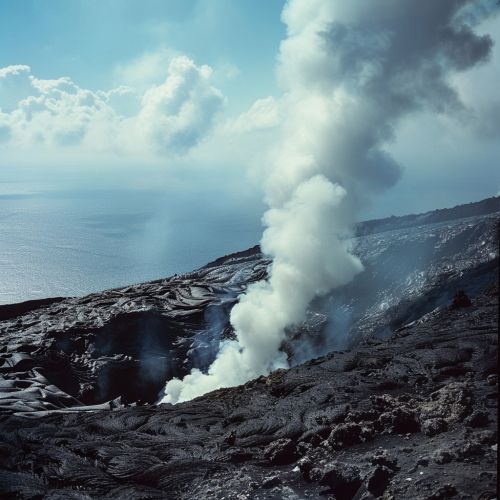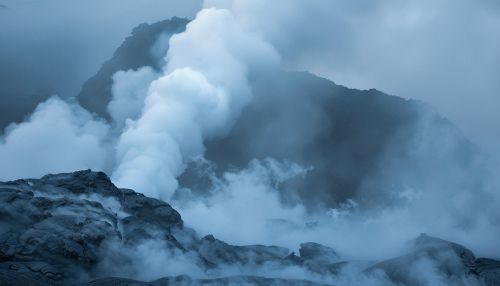Volcanic Gas
Introduction
Volcanic gas refers to the gaseous emissions released from a volcano during both eruptive and non-eruptive phases. These gases play a crucial role in volcanic processes and have significant implications for the environment, climate, and human health. The composition of volcanic gases can vary widely depending on the type of volcano, the nature of the magma, and the stage of the volcanic activity.
Composition of Volcanic Gases
Volcanic gases are primarily composed of water vapor (H₂O), carbon dioxide (CO₂), and sulfur dioxide (SO₂). Other significant components include hydrogen sulfide (H₂S), hydrogen chloride (HCl), hydrogen fluoride (HF), and various trace gases.
Water Vapor (H₂O)
Water vapor is the most abundant gas released during volcanic activity, accounting for up to 97% of the total gas emissions. It originates from the magma and the surrounding hydrothermal systems. The release of water vapor is a critical factor in driving explosive volcanic eruptions.
Carbon Dioxide (CO₂)
Carbon dioxide is the second most abundant volcanic gas. It is a significant greenhouse gas and contributes to the greenhouse effect. The release of large quantities of CO₂ can have profound effects on the global climate. CO₂ is also denser than air and can accumulate in low-lying areas, posing a risk of asphyxiation.
Sulfur Dioxide (SO₂)
Sulfur dioxide is a major component of volcanic gases and is responsible for the formation of volcanic smog or "vog." SO₂ can react with water vapor in the atmosphere to form sulfuric acid (H₂SO₄), leading to acid rain. The presence of SO₂ in the atmosphere can also cause significant cooling by reflecting sunlight.
Hydrogen Sulfide (H₂S)
Hydrogen sulfide is a toxic gas with a characteristic rotten egg smell. It is less abundant than SO₂ but can be hazardous to human health even at low concentrations. H₂S can oxidize to form SO₂ and sulfuric acid in the atmosphere.
Hydrogen Chloride (HCl) and Hydrogen Fluoride (HF)
Hydrogen chloride and hydrogen fluoride are halogen gases released during volcanic eruptions. HCl can contribute to acid rain, while HF is highly toxic and can cause severe health issues, including dental and skeletal fluorosis.
Sources of Volcanic Gases
Volcanic gases originate from several sources, including the degassing of magma, the interaction of magma with surrounding rocks, and the heating of hydrothermal systems.
Magmatic Degassing
Magmatic degassing is the primary source of volcanic gases. As magma ascends towards the surface, the decrease in pressure allows dissolved gases to exsolve and form bubbles. These gas bubbles can coalesce and escape through fractures and vents.
Hydrothermal Systems
Hydrothermal systems are networks of hot water and steam circulating through the Earth's crust. These systems can interact with magma and release gases through fumaroles and hot springs. Hydrothermal activity can continue long after an eruption has ceased.
Environmental and Climatic Impact
Volcanic gases have significant environmental and climatic impacts. The release of large quantities of gases can alter atmospheric composition, affect weather patterns, and contribute to climate change.
Atmospheric Effects
The injection of volcanic gases into the atmosphere can lead to the formation of aerosols and clouds. SO₂, in particular, can form sulfate aerosols that reflect sunlight and cool the Earth's surface. This phenomenon, known as volcanic winter, can lead to temporary global cooling.
Acid Rain
The release of SO₂, HCl, and HF can lead to the formation of acid rain. Acid rain can have detrimental effects on ecosystems, including soil acidification, damage to vegetation, and the acidification of water bodies.
Greenhouse Effect
The release of CO₂ from volcanic eruptions contributes to the greenhouse effect. While volcanic CO₂ emissions are relatively small compared to anthropogenic sources, they can still influence global climate over long timescales.
Health Hazards
Volcanic gases pose several health hazards to humans and animals. The inhalation of toxic gases can lead to respiratory issues, eye irritation, and other health problems.
Respiratory Issues
Exposure to SO₂ and H₂S can cause respiratory problems, including bronchitis, asthma, and other lung diseases. Long-term exposure to low concentrations of these gases can also have chronic health effects.
Eye Irritation
Volcanic gases can cause eye irritation and damage. SO₂ and HCl can react with moisture in the eyes to form acids, leading to pain, redness, and potential long-term damage.
Fluorosis
Exposure to HF can lead to fluorosis, a condition caused by excessive intake of fluoride. Dental fluorosis results in the mottling of teeth, while skeletal fluorosis can cause joint pain and damage to bones.
Monitoring and Mitigation
Monitoring volcanic gases is crucial for understanding volcanic activity and mitigating potential hazards. Various techniques are used to measure gas emissions and assess their impact.
Gas Sampling
Direct gas sampling involves collecting gas samples from fumaroles, vents, and other emission sources. These samples are analyzed in laboratories to determine their composition and concentration.
Remote Sensing
Remote sensing techniques, such as satellite observations and ground-based spectrometers, are used to monitor volcanic gas emissions. These methods provide real-time data on gas concentrations and distribution.
Mitigation Strategies
Mitigation strategies include the establishment of exclusion zones, the use of gas masks and other protective equipment, and the implementation of early warning systems. Public education and awareness campaigns are also essential for reducing the risks associated with volcanic gases.
Conclusion
Volcanic gases are a critical component of volcanic activity with significant implications for the environment, climate, and human health. Understanding their composition, sources, and effects is essential for mitigating their impact and improving our knowledge of volcanic processes.


